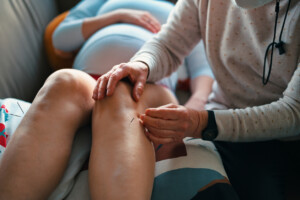Most pregnant women fear them, but stretch marks aren’t the end of the world. (A sweet baby is worth whatever battle scars may be left behind!) As moms, our first concern is bringing a healthy, happy baby into the world. But if you’re looking for a few ways to prevent stretch marks or the “badge of motherhood” during pregnancy, using a few tried and true tricks to reduce them never hurts.
What Are Pregnancy Stretch Marks?
First, let’s talk about what stretch marks are. According to the American Academy of Dermatology, about 90% of women will get stretch marks sometime after their sixth or seventh month of pregnancy.1,2 There are many factors to consider when it comes to getting stretch marks during pregnancy. Much of this concerns how much weight you gain, how much your stomach and skin stretch, and your genetic makeup regarding skin elasticity and collagen.8
Here are four things you may not know about stretch marks:
- Stretch marks are tiny tears in the supporting layers of tissue under your skin as it’s pulled tight to the limit during pregnancy.3
- Susceptibility has a lot to do with genetics. Chances are, if your mother got them, there’s an increased chance you’ll also develop stretch marks.4
- Studies show that rapid pregnancy weight gain can make you more likely to get stretch marks.5
- Darker-skinned moms are less likely to get stretch marks than fair-skinned moms during pregnancy (plus, they’re not as visible on dark skin).6
7 Tips To Reduce Stretch Marks During Pregnancy
Try as you might to avoid stretch marks, there’s no official, proven way to treat them or stop them from zigzagging their way across your body.8,9 The good news is that while they’re not entirely avoidable, there are a few tried and true tricks to prevent or reduce stretch marks during pregnancy:
1. Eat Right
I make it a point to nourish my skin not just from the inside but also from the outside. You’re probably already eating healthy, balanced meals to ensure your baby gets enough vitamins and nutrients. Incorporating foods that are especially beneficial for the health of your skin can improve your skin’s elasticity, which helps prevent pregnancy stretch marks from forming.13 Add the following foods to your daily diet:
- Foods rich in antioxidants: These help nourish and protect skin. Eat plenty of spinach, blueberries, strawberries, and other fresh fruits and vegetables.11,12
- Foods containing vitamin E: This vitamin protects skin cell membranes. Eat nuts, seeds, avocados, broccoli, and collard greens.10,14,15
- Foods containing vitamin A: Vitamin A repairs skin tissues. Eat carrots, sweet potatoes, mangoes, squash, and red bell peppers.3,6,16
- Foods containing omega 3s: These keep cell membranes healthy and make your skin glow. Eat fish, fish oil, walnuts, eggs and oysters.10,17
2. Exercise
Exercising helps the skin retain its elasticity by improving the body’s circulation.6 As an added benefit, exercise will help prevent you from gaining too much weight too quickly, nipping stretch marks in the bud.4 Incorporate exercise into your daily schedule — even if it’s just a walk. I always focus on exercises meant to make pregnancy easier on my body. Stretches, strengthening exercises, and other simple movements can help keep your blood moving and make you more comfortable during pregnancy.
3. Watch Your Weight
Keep an eye on that scale during pregnancy and put your pounds on slow and steady instead of in big spurts.2,5,6 Remember that eating for two doesn’t mean literally eating twice as much. So, as much as possible, try to keep your weight gain to a healthy level.3,8
4. Stay Hydrated
We have all heard that drinking water is excellent for the body, and this rule applies even more when you are pregnant. Water helps detoxify the body and helps your skin cope with the stress of stretching.6,13 Ideally, you should drink eight to 12 cups of water daily.18 Adding foods with high water content to your diet is also a great way to stay hydrated and keep your skin free of stretch marks. Include foods like watermelons, strawberries, and cucumbers in your diet to help your skin stretch easily, keeping pregnancy stretch marks at bay.
5. Avoid Harsh Chemicals
Many commercial body washes contain sulfates, which can dry out your skin and reduce its elasticity over time.19 Choose a cleanser made with natural oils that will hydrate your skin rather than making it lose too much moisture. I typically use coconut oil, which can act as a healthy skin cleanser. Rub it over your skin, rinse with warm water, and pat your skin dry with a soft towel.
6. Improve Skin Elasticity With Supplements
When skin loses elasticity, it can no longer return to its proper size.2 Skin elasticity naturally decreases as we age, but this is an issue women of all ages face. In terms of improving elasticity, research shows this is primarily an inside job.20 If you can’t get all the vitamins and minerals you need from whole foods, the supplements we take can help:
Vitamin C
Vitamin C is essential for producing collagen and elastin.13 Aging and exposure to sunlight or pollutants deplete the amount of vitamin C in the skin, and consuming vitamin C boosts its levels.21 Women should get 75 milligrams daily, but during pregnancy, you should aim for 120 milligrams instead.22 You can get about 150% of your daily intake by eating a medium bell pepper. Other good sources include broccoli, oranges, cabbage, potatoes, strawberries, and cantaloupe.23
Vitamin E
Vitamin E works inside your skin as an antioxidant. Reactive molecules known as free radicals are produced when skin is exposed to sunlight or other environmental stressors.14,15 Vitamin E neutralizes free radicals before they harm skin cells in the skin’s barrier. Since sunlight and free radicals also damage collagen and elastin, antioxidant protection helps maintain the skin’s strength. The recommended dietary allowance for vitamin E is 15 milligrams a day.15 The best dietary sources are sunflower seeds, wheat germ, peanuts, almonds, and hazelnuts.14,15
Vitamin D
Vitamin D helps regulate the growth of new skin cells.24 Since new cells form the skin’s protective barrier, they retain moisture and maintain flexible skin.25 You also need vitamin B-12, folate, and vitamin B-6 for their ability to lower blood levels of the amino acid homocysteine.26 High levels of homocysteine may block enzymes essential for the normal meshing of collagen and elastin. Other B vitamins, including biotin and niacin, also contribute to healthy skin.27 Since these vitamins come from diverse food sources, eating a balanced diet with plenty of low-sugar fruits, fibrous vegetables, and lean protein is the best strategy.
7. Massage With the Right Lotion
Save your money on expensive creams . . . no stretch mark cream is the miracle cure it’s sold as. But there are benefits to moisturizing daily. This will help with the baby belly dryness and itchy skin associated with pregnancy!2
The areas most prone to stretch marks during pregnancy are your tummy, sides, lower back, thighs, and legs since these areas undergo the most strain as your baby grows.2,3 Therefore, to help the skin in these areas stretch without forming marks, the skin needs to be well-moisturized.10 Your ordinary moisturizer might not do the trick since it cannot penetrate deep enough into the skin.
During pregnancy, gently massage the areas most prone to stretch marks with the right type of lotion twice daily. While many products on the market are scams, studies show there may be benefits to using a lotion on your skin that contains collagen and vitamins E, A, C, and K to help firm up loose skin.7
Ideas include something like this firming butter that has cocoa butter, collagen, elastin, and shea butter to support skin elasticity and texture. The firming butter has the addition of ginseng and vitamin E, which help soften and rejuvenate skin. You could also look for a lotion like this with a soothing blend of vitamin K, aloe vera, cocoa butter, and essential oils. No matter what you decide to use, when you apply the lotion, be sure to massage it in.
We hope these tips will help prevent or reduce your pregnancy stretch marks! Remember, it’s very common for women to get stretch marks during pregnancy. And while you may not like how they look, you may be relieved to know they aren’t dangerous and may even fade in appearance over time.4,8













